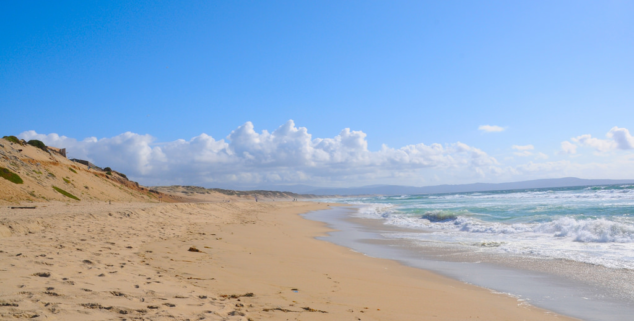Opinion
Marina bears heavy burden in desalination dispute
 Marina Beach north of Monterey, near the site of a planned desalination plant. (Photo: Marina Coast Water District)
Marina Beach north of Monterey, near the site of a planned desalination plant. (Photo: Marina Coast Water District)In parched, drought-stricken California, where water is considered liquid gold, the politics of power and wealth are playing out in real-time.
The California Public Utilities Commission’s (CPUC) recent decision to allow the California American Water Company (Cal-Am) to proceed with its Monterey Peninsula Water Supply Project desalination plant is great news – that is, if you live in Carmel, Pacific Grove or Monterey.
But the City of Marina, where less affluent residents live and where the actual desalination plant will pull water from, will bear only the consequences of the project without receiving any of the water produced.
The problem is that for more than seventy years, seawater intrusion has plagued those dependent upon the Salinas Valley Groundwater Basin for freshwater
Cal-Am is hedging that by siting its groundwater pumping project in working-class Marina, regulatory bodies will quietly issue necessary approvals, even though the project ignores important environmental protections, tramples on the rights of Marina residents, and allows further seawater intrusion into the local water supply.
Although the CPUC rationalized their decision, other regulatory agencies, namely the California Coastal Commission and the State Lands Commission cannot – and must not – ignore these realities.
Water in the Monterey peninsula is supplied via private, for-profit Cal-Am, which in 1995 was ordered to terminate its unlawful diversions from the Carmel River. In response, Cal-Am proposed a solution that included placing an industrial pumping and desalination operation in the City of Marina. That project will pump large amounts of water from the Salinas Valley Groundwater Basin, the basin that serves as Marina’s main source of water.
The problem is that for more than seventy years, seawater intrusion has plagued those dependent upon the Salinas Valley Groundwater Basin for freshwater. As the Cal-Am project draws primarily groundwater, not seawater, from the basin, an independent team of researchers from Stanford concluded that it will cause additional seawater intrusion. That will lead to depletion and degradation of a critically over-drafted groundwater basin that is – at least in theory — protected by the state’s Sustainable Groundwater Management Act.
Ironically, the City of Marina doesn’t even receive water through Cal-Am and will not receive a drop of water from the proposed project
The proposed desalination plant also violates the spirit of the California Coastal Act, which has protected local communities from developments that damage coastlines and run contrary to the will of local communities. Cal-Am says that it will “remediate” any damage. This is not the same thing as assuring that damage won’t occur.
There are viable, environmentally sound alternatives to the Cal-Am project. Numerous experts have testified that other sources of water, including expansion of the Pure Water Monterey project and water sales from Marina Coast Water District, could meet the demand. The alternative projects could meet demand in a much more responsible, affordable, and sustainable manner.
Ironically, the City of Marina doesn’t even receive water through Cal-Am and will not receive a drop of water from the proposed project. So why push forward to locate the project in Marina?
One clue about the decision to pursue the path of least resistance lies in Flint, Michigan.
It’s been four years since high levels of lead, E. coli, and other toxins were discovered in Flint’s water system, yet the corroded pipes have still not been replaced and the low-income residents of that city still have little access to clean drinking water. Racial and class undertones in the Flint debacle cannot be ignored, given that many low-income residents and people of color cannot afford to move out of the region.
Marina is not Flint, Michigan, and the Cal-Am water project poses environmental and supply risks, not a health threat. But just as we must question whether delays would continue in Flint if it were a higher-income community, we should also ask Cal-Am’s champions whether they would feel the same way about the project risks and benefits if they actually lived in Marina.
We residents of Marina have faith that the California Coastal Commission and the State Lands Commission will honor their commitments to carefully protect our precious lands and resources for present and future generations. If those Commissioners believe our community matters just as much as our neighbors, they will clearly reject the Cal-Am project in its entirety.
—
Editor’s Note: Bruce Delgado is the mayor of the city of Marina.
Want to see more stories like this? Sign up for The Roundup, the free daily newsletter about California politics from the editors of Capitol Weekly. Stay up to date on the news you need to know.
Sign up below, then look for a confirmation email in your inbox.

Bruce is right…furthermore, the private, for-profit company, Cal-Am, is spending many, many thousands of dollars of rate-payer provided money to fight Measure J, which would mandate that the Monterey Peninsula Water Management District own and operate all water infrastructure. This would effectively force Cal-Am to sell to the district its assets in the area. Obviously, they don’t want to do that.
While kicking out Cal-Am might be one path towards slowing or stopping the plan to outsource the environmental impact of their plan to Marina. Yet, Marina doesn’t get to vote on Measure J, even though we will likely bear much of the burden should it fail.
When will the lesser cities around the Monterey Peninsula fully grasp the fact they exist in order to supply the vegetables, the retail shopping outlets, the budget housing, the physical labor…and the water…for the important affluent Liberals of Carmel, PG and Monterey.
Sheesh…where’s the gratitude from these people and towns for being allowed to bathe in the glory of the important three cities!